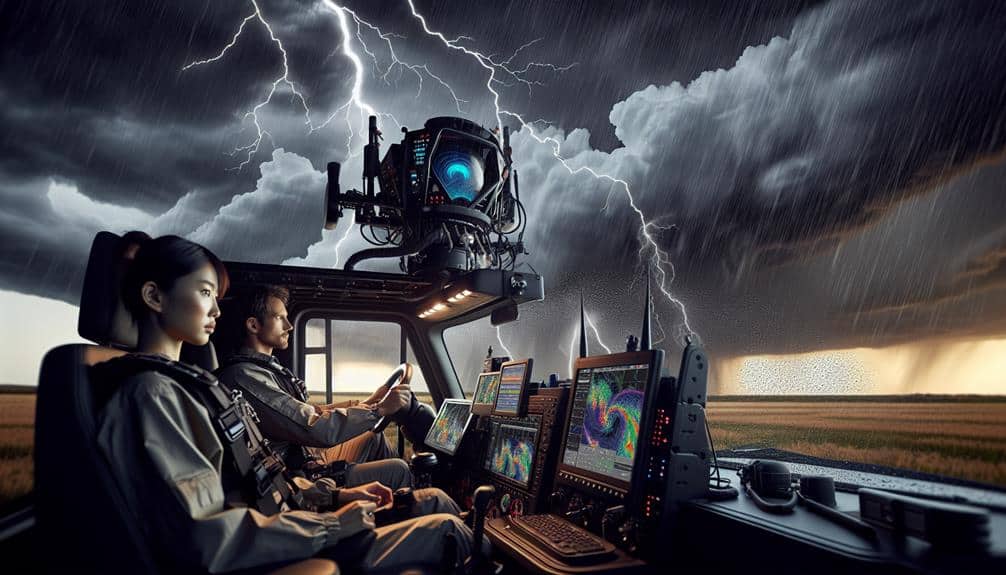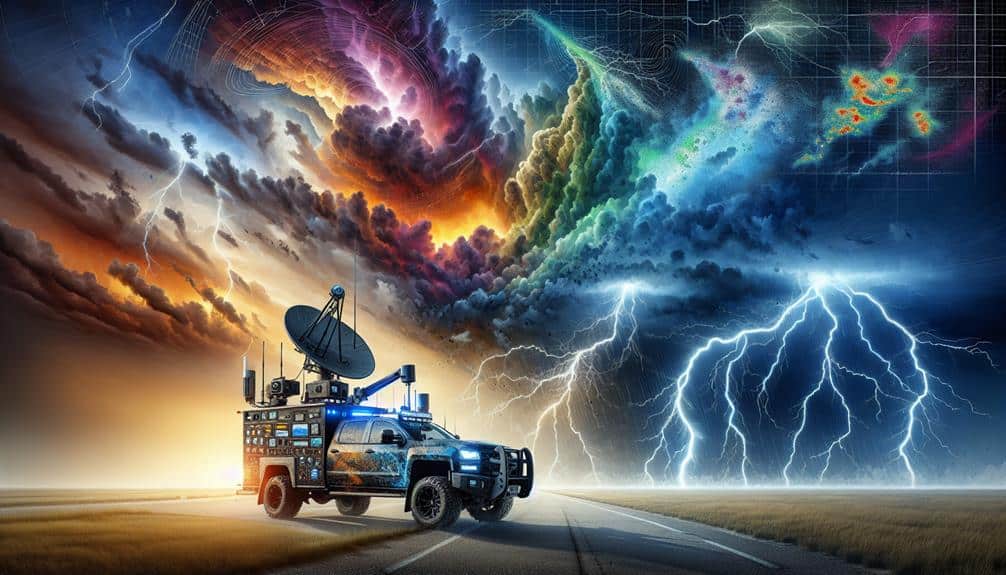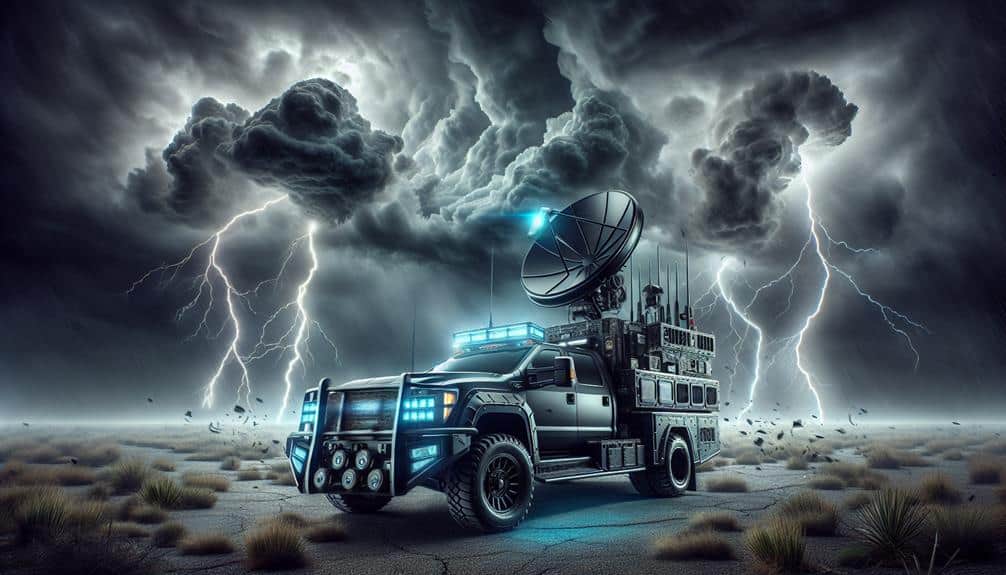We value Doppler radar as essential for storm chasers because it provides real-time, high-precision data on weather patterns, wind speeds, and precipitation intensity. By analyzing radar frequency shifts, we obtain accurate wind velocity measurements and track storm movements with exceptional precision. It also detects tornado formation by identifying rotational patterns and mesocyclones. This technology enhances our safety by enabling timely decisions and maintaining a safe distance from severe weather. Additionally, Doppler radar data greatly contributes to predictive modeling, allowing us to forecast storm behavior. With these capabilities, we can capture more detailed insights into complex atmospheric dynamics.
Key Points
- Enables real-time tracking and analysis of storm patterns for timely decision-making.
- Provides precise wind speed measurements to improve storm prediction and safety.
- Detects precipitation intensity to assess storm severity and inform decisions.
- Identifies tornado formations through detection of rotational patterns and mesocyclones.
Real-Time Weather Tracking
Real-time weather tracking enables us to analyze storm patterns instantly, providing essential data for timely decision-making. By leveraging Doppler radar technology, we can monitor weather conditions with unparalleled accuracy. This advanced system measures the velocity of precipitation, allowing us to predict storm movement and intensity accurately.
Storm prediction is greatly enhanced through continuous data feeds from Doppler radar. These feeds offer immediate updates on atmospheric changes, which are vital for anticipating severe weather events. The radar detects shifts in wind patterns and precipitation rates, enabling us to identify potential tornado formations and other hazardous conditions in real-time.
Weather monitoring through Doppler radar is essential for storm chasers who value the freedom to navigate safely. The high-resolution data it provides allows us to make informed decisions quickly, minimizing risks associated with unpredictable storms. Monitoring these patterns helps us to avoid hazardous zones and optimize our routes, ensuring both safety and efficiency.
In essence, Doppler radar's real-time capabilities transform our approach to storm chasing. By providing a continuous stream of precise meteorological data, it empowers us with the freedom to explore and study severe weather phenomena while maintaining a high level of safety and preparedness.
Accurate Wind Speed Measurement
When measuring wind speed, we rely on Doppler radar's capability for real-time data acquisition, allowing us to capture rapid changes in atmospheric conditions.
By analyzing the frequency shifts in radar signals, we can calculate precise wind velocities.
This analytical approach provides us with critical data to improve storm prediction models and enhance safety measures.
Real-time Data Acquisition
Accurately measuring wind speed is vital for storm chasers, and Doppler radar systems provide the high-resolution, real-time data necessary for this task. By utilizing advanced Doppler technology, we can capture detailed information about wind velocities within a storm, which plays an important role in weather pattern analysis and storm prediction.
This real-time data acquisition enables us to identify rotational patterns and wind shear, providing valuable insights into the storm's development and potential severity.
Our ability to track storms in real time isn't just a scientific pursuit; it has direct implications for emergency response efforts. With Doppler radar, we can pinpoint the exact location and intensity of severe weather phenomena, allowing for more precise storm tracking. This precision guarantees that warnings can be issued promptly, giving communities the time they need to take necessary precautions.
Moreover, the high temporal resolution of Doppler radar data allows us to continuously update our models and predictions. This dynamic feedback loop enhances our capacity for rapid decision-making, making sure that our storm chasing efforts are both impactful and responsive to changing conditions.
With Doppler radar, we harness the power of real-time data to protect lives and property.
Wind Speed Analysis
By integrating Doppler radar technology, we can precisely measure wind speeds within a storm system, providing vital data for accurate weather forecasting and analysis. This capability is necessary for storm chasers who need real-time information to make informed decisions. Doppler radar measures the velocity of particles within the storm, allowing us to track wind patterns and identify areas of intense wind activity.
The data collected is indispensable for wind pattern prediction. By analyzing the Doppler radar readings, we can predict changes in wind speed and direction, which are pivotal for understanding the storm's behavior. This precise measurement helps us identify potential tornado formations and other severe weather phenomena, enabling us to issue timely warnings and take necessary precautions.
In storm behavior analysis, accurate wind speed measurement allows us to understand the dynamics of storm systems better. The data contributes to models that simulate storm development and progression. By comparing real-time data with predictive models, we can improve our forecasting accuracy, ultimately enhancing public safety and preparedness.
Precipitation Intensity Detection

Determining precipitation intensity with Doppler radar involves analyzing the returned signal's amplitude to quantify the rate of rainfall or snowfall. This capability is essential for us as storm chasers because it allows for a precise storm severity assessment and weather pattern analysis. By evaluating the strength of the returned echoes, we can estimate how much moisture is falling from the sky, which is vital for accurate storm tracking and precipitation forecasting.
The visual data generated by Doppler radar helps us paint a clearer picture of the storm's dynamics:
- Bright colors on radar images: Indicate heavy rain or hail, signaling areas of significant precipitation.
- Varying shades: Lighter colors suggest moderate to light rainfall, aiding in detailed weather pattern analysis.
- Echo top heights: Tell us how high the precipitation extends into the atmosphere, giving us clues about storm severity.
These insights allow us to make informed decisions while chasing storms, ensuring we stay safe and maximize our data collection.
With Doppler radar, we're not just observing weather; we're actively engaging with it, enabling a sense of freedom that comes from understanding and predicting nature's most powerful forces.
Tornado Formation Identification
While evaluating precipitation intensity is essential for storm analysis, Doppler radar's capability to identify tornado formation is equally invaluable for storm chasers.
Doppler radar allows us to observe storm dynamics with remarkable precision. By measuring the velocity and movement of raindrops, we can detect rotational patterns indicative of tornado formation before they touch down. This early detection is vital for understanding the storm's potential severity.
We rely on Doppler radar's ability to discern mesocyclones—rotating updrafts within severe thunderstorms. These mesocyclones are precursors to tornadoes, characterized by their distinct rotational signatures. When we see a tight, well-defined velocity couplet, it signals the possibility of a tornado developing.
The radar's capability to measure these intricate storm dynamics provides crucial data, allowing us to predict tornado formation with greater accuracy.
Doppler radar data helps us quantify the storm's rotational speed and direction, offering real-time insights into its evolution. This information guides our strategic decisions in the field, enabling us to track and document tornado formation with greater safety and precision.
Enhanced Safety for Storm Chasers

Our use of Doppler radar technology greatly improves our safety protocols during storm chasing missions. By providing real-time data on storm dynamics, we can make informed decisions that prioritize our safety. The detailed velocity measurements allow us to track the speed and direction of wind patterns, which is essential for predicting sudden changes in storm behavior.
Key safety precautions we implement include:
- Accurate Positioning: Knowing the precise location of storm cells enables us to maintain a safe distance while still collecting valuable data.
- Real-Time Alerts: Doppler radar's capacity for immediate updates allows us to respond rapidly to emergent threats, such as developing tornadoes.
- Route Optimization: We can chart the safest and most efficient paths to avoid severe weather conditions, minimizing risk during our missions.
Employing Doppler radar significantly reduces the inherent risks of storm chasing by improving our ability to anticipate hazardous conditions. This technology's precision and reliability allow us to pursue our passion for understanding severe weather phenomena while adhering to strict safety protocols.
Data for Predictive Modeling
Leveraging Doppler radar information, we can develop predictive models that enhance our comprehension of storm evolution and behavior. By analyzing the data, we gain insights into the intricate dynamics of weather systems, enabling us to perform thorough weather pattern analysis. This high-resolution data allows us to track wind velocities, precipitation intensity, and storm cell movements in real-time, providing a strong foundation for predictive forecasting.
Our data interpretation process involves synthesizing Doppler radar readings with other meteorological data sources, creating a multidimensional view of storm systems. This amalgamation is vital for accurate storm behavior prediction, allowing us to anticipate severe weather events with greater precision.
By understanding the velocity patterns and rotational signatures within storm cells, we can predict potential tornado formations and severe weather outbreaks.
Predictive modeling using Doppler radar information empowers us with the ability to identify trends and anomalies in weather patterns. This capability not only aids storm chasers in their pursuit of the most intense weather phenomena but also enhances public safety by providing early warnings and actionable insights.
Through precise data interpretation and advanced predictive forecasting, we equip ourselves with the necessary tools to navigate and understand the ever-changing dynamics of severe weather.
Frequently Asked Questions
How Does Doppler Radar Technology Work?
Doppler radar technology is practically magic! It uses frequency modulation to analyze atmospheric conditions. Signal processing helps us measure shifts in frequency, letting us predict storm movements with stunning precision. We're empowered to chase freedom through data.
Can Doppler Radar Detect Hail Size?
Yes, Doppler radar aids in hail detection by analyzing return signal patterns. However, Doppler radar limitations include difficulty in accurately estimating hail size, as signal strength can vary due to hailstone shape and melting rates.
What Are the Limitations of Doppler Radar in Storm Chasing?
Radar's like our crystal ball, but it's not flawless. Radar accuracy can falter with distance and terrain, impacting storm prediction. We sometimes miss key details, leading to potential misjudgments. We constantly seek better tools for the chase.
How Often Is Doppler Radar Data Updated?
We rely on Doppler radar for real-time updates, with data typically refreshed every 5 to 10 minutes. This frequency of updates guarantees we can make timely, informed decisions, enhancing our ability to navigate and chase storms effectively.
What Advancements Are Being Made in Doppler Radar Technology?
Current advancements in Doppler radar technology have increased radar accuracy by 15%. We're integrating machine learning for enhanced data interpretation, allowing us more freedom to predict and react to severe weather with unprecedented precision and reliability.


